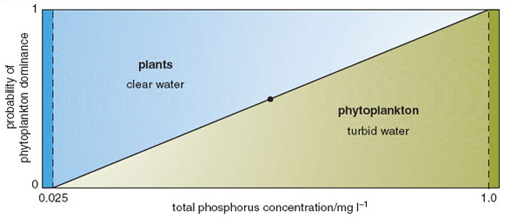3.3 Mechanisms of eutrophication
Direct effects of eutrophication occur when growth of organisms (usually the primary producers) is released from nutrient limitation. The resulting increased NPP becomes available for consumers, either as living biomass for herbivores or as detritus for detritivores. Associated indirect effects occur as eutrophication alters the food supply for other consumers. Changes in the amount, relative abundance, size or nutritional content of the food supply influence competitive relationships between consumers, and hence the relative success and survival of different species. Nutrient-induced changes in plant community composition and productivity can therefore result in associated changes in the competitive balance between herbivores, detritivores and predators. Consumers may also be affected by changes in environmental conditions caused indirectly by eutrophication, for example reduced oxygen concentrations caused by bacterial decay of biomass.
In freshwater aquatic systems, a major effect of eutrophication is the loss of the submerged macrophyte community (Section 2.1.1). Macrophytes are thought to disappear because they lose their energy supply in the form of sunlight penetrating the water. Following eutrophication, the sunlight is intercepted by the increased biomass of phytoplankton exploiting the high availability of nutrients. In principle, the submerged macrophytes could also benefit from increased nutrient availability, but they have no opportunity to do so because they are shaded by the free-floating microscopic organisms. Research in the Norfolk Broads has supported the view that the rapid replacement of diverse macrophyte communities by algal communities is attributable to light attenuation, caused by raised turbidity, but has also suggested that there may be more complex mechanisms operating, which must be understood if practical measures are to be undertaken to tackle eutrophication problems. There is evidence to suggest that either a plant-dominated state or an algal-dominated state can exist under high-nutrient conditions (Figure 3.5). Once either state becomes established, a number of mechanisms come into play which buffer the ecosystem against externally applied change. For example, a well-established submerged plant community may secrete substances that inhibit algal growth, and may provide refuges for animals that graze large quantities of algae. On the other hand, once an algal community becomes well established, especially early in the year, it can shade out the new growth of any aquatic plants on the bottom and compete with them for carbon dioxide in the water.

Research in the Norfolk Broads into possible trigger factors for switches from communities dominated by submerged macrophytes to those dominated by algae suggests that pesticides could play a role. Some herbivores are thought to be susceptible to pesticide leaching from surrounding arable land. Pesticide residues in sediments were found at concentrations high enough to cause at least sub-lethal effects, which could reduce the herbivore population for long enough to reduce algal consumption. This could help to explain the observation that most of the Norfolk Broads that have lost their plants are directly connected with main rivers draining intensive arable catchments, whereas those that have retained plant dominance are in catchments where livestock grazing predominates.
Clear relationships can be seen between human population density and total phosphorus and nitrate concentrations in watercourses (Figure 3.6). In 1968 the anthropogenic contribution amounted to some 10.8 g N per capita per day and 2.18 g P per capita per day. Outputs have continued to rise since then. Worldwide, human activities have intensified releases of phosphorus considerably. Increased soil erosion, agricultural runoff, recycling of crop residues and manures, discharges of domestic and industrial wastes and, above all, applications of inorganic fertilizers, are the major causes of this increase. Global food production is now highly dependent on the continuing use of supplementary phosphates, which account for 50-60% of total phosphorus supply.

Studies of nutrient runoff have shown a mixture of inputs into most river and lake catchments: both point source (such as sewage treatment works) and diffuse source (such as agriculture). Point sources are usually most important in the supply of phosphorus, whereas nitrogen is more likely to be derived from diffuse sources.
Question 3.1
Using the data presented in Figure 1.13 and Table 2.3, comment on whether the remediation activities on the broads neighbouring the River Ant were likely to have resulted in a recovery of plant species diversity by 2000. Assume that 80% of the total phosphorus in the water is in the form of SRP.
Answer
Figure 1.13 shows that total phosphorus concentrations had fallen to 0.2 mg 1−1 in 2000, compared with their peak concentration of 0.36 mg 1−1 in 1975. In terms of SRP (the form of phosphorus that affects ecosystems most directly), we assume levels have fallen from 0.29 mg 1−1 to 0.16 mg 1−1. Comparing these figures with those in Table 2.3, we see that the SRP concentration put the system in the ‘severe loss of species’ category in 1975, but only the ‘degraded’ category in 2000. This suggests that some recovery of macrophyte species would be possible. Actual re-colonization may be a slow process, however. Ecosystems can take many years to come back to equilibrium after a perturbation, and if an algal-dominated state has established, it will inhibit macrophyte recovery.
